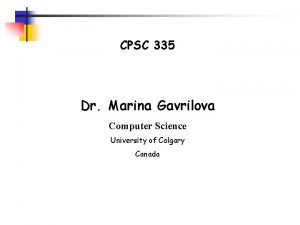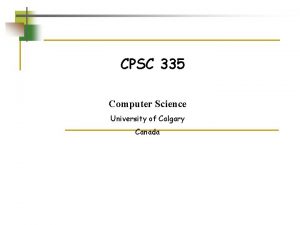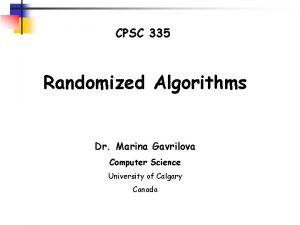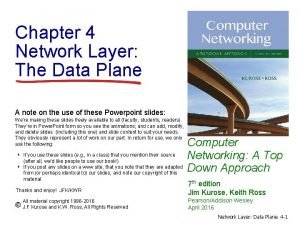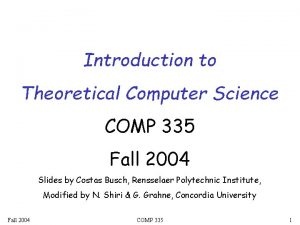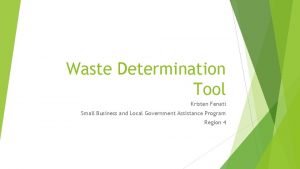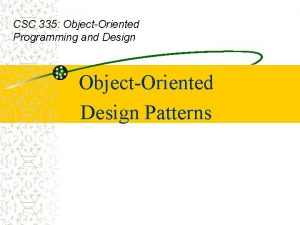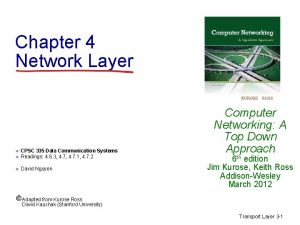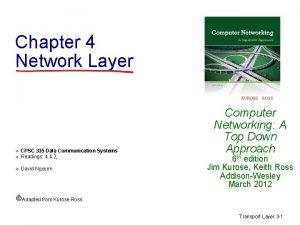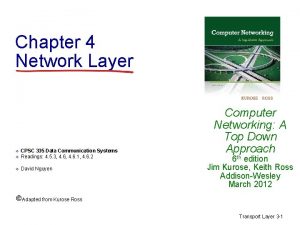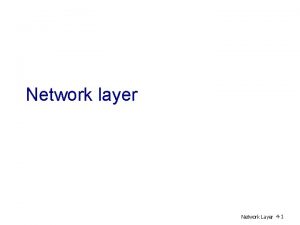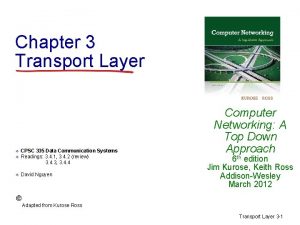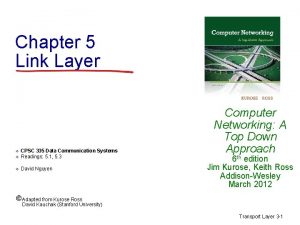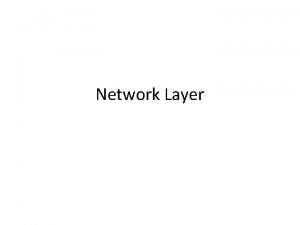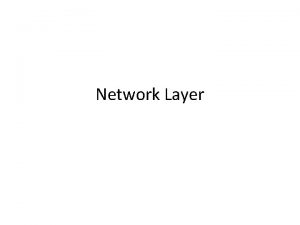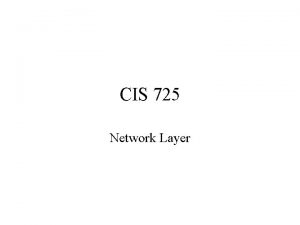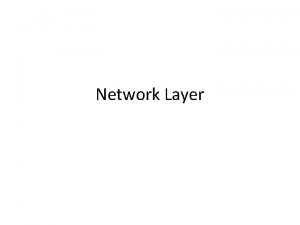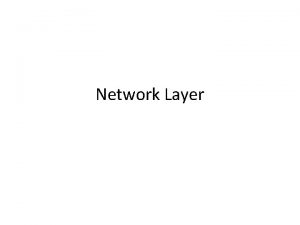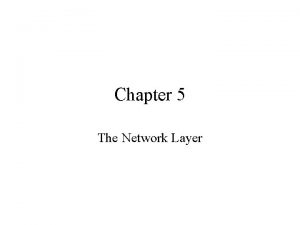Chapter 4 Network Layer v CPSC 335 Data


















- Slides: 18

Chapter 4 Network Layer v CPSC 335 Data Communication Systems Readings: 4. 4. 3, 4. 4. 4, 4. 5. 1 v David Nguyen v Computer Networking: A Top Down Approach 6 th edition Jim Kurose, Keith Ross Addison-Wesley March 2012 Adapted from Kurose Ross Transport Layer 3 -1

Chapter 4: outline 4. 1 introduction 4. 2 virtual circuit and datagram networks 4. 3 what’s inside a router 4. 4 IP: Internet Protocol § § datagram format IPv 4 addressing ICMP IPv 6 4. 5 routing algorithms § link state § distance vector § hierarchical routing 4. 6 routing in the Internet § RIP § OSPF § BGP 4. 7 broadcast and multicast routing Network Layer 4 -2

ICMP: internet control message protocol v used by hosts & routers to communicate network -level information § error reporting: unreachable host, network, port, protocol § echo request/reply (used by ping) v network-layer “above” IP: § ICMP msgs carried in IP datagrams v ICMP message: type, code plus first 8 bytes of IP datagram causing error 0 3 3 3 4 8 9 10 11 12 Type Code description 0 echo reply (ping) 0 dest. network unreachable 1 dest host unreachable 2 dest protocol unreachable 3 dest port unreachable 6 dest network unknown 7 dest host unknown 0 source quench (congestion control - not used) 0 echo request (ping) 0 route advertisement 0 router discovery 0 TTL expired 0 bad IP header Network Layer 4 -3

IPv 6: motivation initial motivation: 32 -bit address space soon to be completely allocated. v additional motivation: v § header format helps speed processing/forwarding § header changes to facilitate Qo. S IPv 6 datagram format: § fixed-length 40 byte header § no fragmentation allowed Network Layer 4 -4

IPv 6 datagram format priority: identify priority among datagrams in flow Label: identify datagrams in same “flow. ” (concept of“flow” not well defined). next header: identify upper layer protocol for data ver pri flow label payload len next hdr hop limit source address (128 bits) destination address (128 bits) data 32 bits Network Layer 4 -5

Other changes from IPv 4 checksum: removed entirely to reduce processing time at each hop v options: allowed, but outside of header, indicated by “Next Header” field v ICMPv 6: new version of ICMP v § additional message types, e. g. “Packet Too Big” § multicast group management functions Network Layer 4 -6

Transition from IPv 4 to IPv 6 v not all routers can be upgraded simultaneously § how will network operate with mixed IPv 4 and IPv 6 routers? v tunneling: IPv 6 datagram carried as payload in IPv 4 datagram among IPv 4 routers IPv 4 header fields IPv 4 source, dest addr IPv 6 header fields IPv 6 source dest addr IPv 4 payload UDP/TCP payload IPv 6 datagram IPv 4 datagram Network Layer 4 -7

Tunneling IPv 4 tunnel connecting IPv 6 routers A B IPv 6 A B C IPv 6 IPv 4 logical view: E F IPv 6 D E F IPv 4 IPv 6 physical view: Network Layer 4 -8

Tunneling IPv 4 tunnel connecting IPv 6 routers A B IPv 6 A B C IPv 6 IPv 4 logical view: E F IPv 6 D E F IPv 4 IPv 6 physical view: flow: X src: A dest: F data A-to-B: IPv 6 src: B dest: E Flow: X Src: A Dest: F data B-to-C: IPv 6 inside IPv 4 flow: X src: A dest: F data E-to-F: IPv 6 Network Layer 4 -9

Chapter 4: outline 4. 1 introduction 4. 2 virtual circuit and datagram networks 4. 3 what’s inside a router 4. 4 IP: Internet Protocol § § datagram format IPv 4 addressing ICMP IPv 6 4. 5 routing algorithms § link state § distance vector § hierarchical routing 4. 6 routing in the Internet § RIP § OSPF § BGP 4. 7 broadcast and multicast routing Network Layer 4 -10

Interplay between routing, forwarding routing algorithm determines end-path through network routing algorithm local forwarding table dest address output link address-range 1 address-range 2 address-range 3 address-range 4 forwarding table determines local forwarding at this router 3 2 2 1 IP destination address in arriving packet’s header 1 3 2 Network Layer 4 -11

Graph abstraction 5 2 u v 2 1 x 3 w z 1 3 1 5 y 2 graph: G = (N, E) N = set of routers = { u, v, w, x, y, z } E = set of links ={ (u, v), (u, x), (v, w), (x, y), (w, z), (y, z) } aside: graph abstraction is useful in other network contexts, e. g. , P 2 P, where N is set of peers and E is set of TCP connections Network Layer 4 -12

Graph abstraction: costs 5 2 u v 2 1 x 3 w 3 1 c(x, x’) = cost of link (x, x’) e. g. , c(w, z) = 5 5 z 1 y 2 cost of path (x 1, x 2, x 3, …, xp) = c(x 1, x 2) + c(x 2, x 3) + … + c(xp-1, xp) key question: what is the least-cost path between u and z ? routing algorithm: algorithm that finds that least cost path Network Layer 4 -13

Routing algorithm classification Q: global or decentralized information? global: v all routers have complete topology, link cost info v “link state” algorithms decentralized: v router knows physicallyconnected neighbors, link costs to neighbors v iterative process of computation, exchange of info with neighbors v “distance vector” algorithms Q: static or dynamic? static: v routes change slowly over time dynamic: v routes change more quickly § periodic update § in response to link cost changes Network Layer 4 -14

Chapter 4: outline 4. 1 introduction 4. 2 virtual circuit and datagram networks 4. 3 what’s inside a router 4. 4 IP: Internet Protocol § § datagram format IPv 4 addressing ICMP IPv 6 4. 5 routing algorithms § link state § distance vector § hierarchical routing 4. 6 routing in the Internet § RIP § OSPF § BGP 4. 7 broadcast and multicast routing Network Layer 4 -15

A Link-State Routing Algorithm Dijkstra’s algorithm v net topology, link costs known to all nodes § accomplished via “link state broadcast” § all nodes have same info v computes least cost paths from one node (‘source”) to all other nodes § gives forwarding table for that node v iterative: after k iterations, know least cost path to k dest. ’s notation: v c(x, y): link cost from v v v node x to y; = ∞ if not direct neighbors D(v): current value of cost of path from source to dest. v p(v): predecessor node along path from source to v N': set of nodes whose least cost path definitively known Network Layer 4 -16

Dijsktra’s Algorithm 1 Initialization: 2 N' = {u} 3 for all nodes v 4 if v adjacent to u 5 then D(v) = c(u, v) 6 else D(v) = ∞ 7 8 Loop 9 find w not in N' such that D(w) is a minimum 10 add w to N' 11 update D(v) for all v adjacent to w and not in N' : 12 D(v) = min( D(v), D(w) + c(w, v) ) 13 /* new cost to v is either old cost to v or known 14 shortest path cost to w plus cost from w to v */ 15 until all nodes in N' Network Layer 4 -17

Dijkstra’s algorithm, discussion algorithm complexity: n nodes v v v each iteration: need to check all nodes, w, not in N O(n 2) more efficient implementations possible: O(nlogn) Network Layer 4 -18
 Cpsc 335
Cpsc 335 Cpsc 335
Cpsc 335 Cpsc 335
Cpsc 335 The network layer is concerned with of data
The network layer is concerned with of data Network layer data plane
Network layer data plane Csc 335
Csc 335 Cmsc335
Cmsc335 Comp 335
Comp 335 Cmsc 335
Cmsc 335 30 tac 335
30 tac 335 30 tac 335
30 tac 335 30 tac 335
30 tac 335 Sim 335
Sim 335 What is adoloscence
What is adoloscence Builder design pattern uml diagram
Builder design pattern uml diagram Pigmented layer and neural layer
Pigmented layer and neural layer Git layers
Git layers Secure socket layer and transport layer security
Secure socket layer and transport layer security Presentation layer functions
Presentation layer functions
